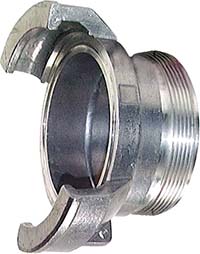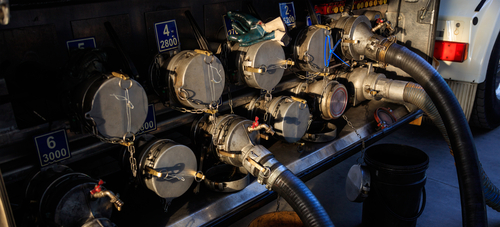Guillemin Couplings

Figure 1: Guilemin couplings with male threads (without lock)
Guillemin couplings are widely used quick-connect couplings for fluid transfer applications involving low to medium pressure. These couplings find applications in firefighting, agriculture, petrochemicals, food processing, and general fluid transportation. This article explores the features, materials, usage, and applications of Guillemin couplings.
Table of contents
View Tameson's selection of Guillemin couplings!
Features
- Guillemin couplings consist of male and female halves that can be easily connected and disconnected without additional tools.
- They can be joined to any other coupling of the same diameter.
- Guillemin couplings provide a tight, leak-proof connection design, minimizing fluid loss and contamination risks.
- The symmetrical nature of Guillemin couplings allows for quick and easy connections regardless of orientation, eliminating the need for separate male and female couplings.
- The Guillemin coupling size is usually marked by its nominal diameter DN (DN20 - DN150).
- Guillemin couplings adhere to EN 14420-8 and NF E 29572 standards.
How to use Guillemin couplings
Guillemin couplings consist of two identical halves with lugs. Align both the lugs with the seals facing each other. Join both the lugs, then rotate the locking ring until they are tight, which causes a watertight connection between the couplings. To further tighten the connection, use a hook wrench to turn the locking rings approximately a quarter turn. Loosen the locking ring and decouple the connections to remove them. Guillemin couplings attach to each other. Alternatively, there are multiple other methods to attach the couplings to other components, like hose pillars, threaded connections, and flanges.
Locking ring and materials
The locking ring on a Guillemin coupling helps to prevent accidental disconnection by providing a mechanism to hold the couplings firmly together. Only one coupling needs to have the locking ring; typically, the locking ring coupling is on the non-fixed installation (i.e. it is on the hose and not the mounted coupling). However, the presence of two locking rings may make it challenging to align the couplings properly and engage or disengage them smoothly.
Only the couplings with the locking rings are equipped with a soft seal, which can be made from FKM, PTFE, or NBR. To get a tighter seal between the couplings, use a Guillemin wrench (also called a key) to tighten the closure ring. Also, they come in various materials and seals, like stainless steel with FKM sealing and aluminum with NBR sealing.

Figure 2: Guillemin wrench
Applications
Guillemin couplings are utilized in water, fluid, hydrocarbon, chemical delivery, and suction-delivery applications. They are also employed for handling loose dry materials like granules and powders. They are unsuitable for steam and certain gasses. A few typical applications are listed below:
- Tanker trucks: Guillemin couplings are extensively used in tanker trucks to load and unload various liquids and bulk materials efficiently. They are designed to be compatible and interchangeable, allowing for seamless integration with different tanker truck systems.
- Silos: Guillemin couplings facilitate the connection of fluid transfer lines to silos, enabling the smooth transfer of bulk materials such as grains, powders, or granular substances. The quick-connect feature of Guillemin couplings simplifies the setup and dismantling of transfer lines, optimizing filling and emptying silos. Guillemin couplings can withstand bulk material handling challenges, ensuring reliable performance and minimizing maintenance requirements.
-
Agriculture:
- Irrigation systems: Guillemin couplings enable quick and easy connection of hoses, pipes, or sprinkler systems, ensuring efficient water distribution for crop irrigation.
- Agricultural machinery: Guillemin couplings are used in various equipment, such as sprayers, pumps, and fertilizer applicators, providing secure connections for fluid transfer. They ensure accurate and efficient distribution of pesticides, fertilizers, or other agricultural inputs, supporting farming operations effectively.

Figure 3: The loading system in a tanker truck
FAQs
How do I select the right size of Guillemin coupling?
The size of a Guillemin coupling is determined by the nominal diameter of the hose or pipe it is intended to connect. Select the coupling size that matches your hose or pipe diameter.
Are Guillemin couplings suitable for high-pressure applications?
Guillemin couplings are primarily designed for medium to low-pressure applications.
What are Guillemin couplings used for?
Guillemin couplings are commonly used for quick and secure connections in fluid transfer applications, such as tanker trucks, silos, and agricultural equipment.





